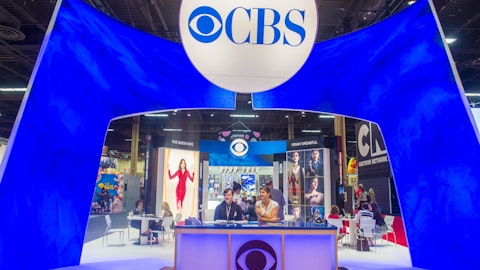Cumulus Media Inc. (NASDAQ:CMLS) Q4 2023 Earnings Call Transcript February 27, 2024
Cumulus Media Inc. misses on earnings expectations. Reported EPS is $-5.94 EPS, expectations were $-0.59. CMLS isn’t one of the 30 most popular stocks among hedge funds at the end of the third quarter (see the details here).
Operator: Hello, and welcome to the Cumulus Media Quarterly Earnings Conference Call. I’ll now turn it over to Collin Jones, Executive Vice President of Strategy and Development and President of Westwood One. Sir, you may proceed.
Collin Jones: Thank you, operator. Welcome, everyone, to our fourth quarter and full year 2023 earnings conference call. I’m joined today by our President and CEO, Mary Berner; and our CFO, Frank Lopez-Balboa. Before we start, please note that certain statements in today’s press release and discussed on this call may constitute forward-looking statements under federal securities laws. Actual results may differ materially from the results expressed or implied in forward-looking statements. These statements are based on management’s current assessments and assumptions, and they are subject to a number of risks and uncertainties as discussed in our filings with the SEC. In addition, we will also use certain non-GAAP financial measures.
We believe the supplementary information is useful to investors, although it should not be considered superior to the measures presented in accordance with GAAP. A full description of these risks as well as financial reconciliations to non-GAAP terms are in our press release and SEC filings. The press release can be found in the Investor Relations portion of our website and our Form 10-K was also filed with the SEC shortly before this call. A recording of today’s call will be available for about a month via link in the Investors portion of our website. With that, I’ll now turn it over to our President and CEO, Mary Berner. Mary?
Mary Berner: Thanks, Collin, and good morning, everyone. It has been well documented that 2023 was a tough year across the media landscape. Unsupportive macro factors, including persistent inflation, rising interest rates and a barrage of geopolitical issues, combined with the general uncertainties depressed advertiser confidence throughout the year. However, while we couldn’t escape the effects of the weak environment, we were able to offset some of its impact on the year by solid execution in key focus areas, specifically by growing our digital businesses, reducing costs and improving our balance sheet. Looking ahead to 2024, while there are some green shoots, we still have limited visibility into ad demand, particularly with respect to national advertisers.
That said, our industry-leading performance during other weak macro environments gives us significant confidence in our ability to navigate these current headwinds and rebound strongly when we see a return to a better advertising climate. Supplementing those efforts, this morning we announced that we are launching a debt exchange to extend our maturities and further reduce our net leverage. I’ll touch on that later, but first, our 2023 key highlights, starting with digital which is not only the fastest-growing area of the company, but also one that provides us with new ways to capitalize on our longstanding radio relationships. In aggregate, our digital businesses generated $146 million of revenue in 2023, representing 17% of our total revenue and an increase of 3% year-over-year.
In the fourth quarter alone, these businesses produced $40 million of revenue, 18% of our total revenue for the quarter, an increase of 5% from the prior year. As I’ve said and we’ve said before, digital, which has been built profitably and organically from day one has three primary revenue streams: Digital marketing services, streaming and podcasting. In 2023, digital marketing services grew 13%, finishing the year at $45 million annual revenue run rate. We continue to be excited about the opportunities this business is presenting us both to expand our customer base beyond broadcast radio buyers and to increase revenue and deepen our relationships with our radio customers. To the former point, one-third of our DMS clients are new to the company.
In part, the magnitude of this digital-only group reflects the traction that we’re gaining with Cumulus Boost, a portfolio of presence products, including website design, reputation management and search engine optimization which complements our existing digital campaign products. The number of our Boost clients has nearly tripled since the beginning of 2023. That rapid acceleration reflects the fact that Boost serves as both an entry-level product, giving us the ability to serve customers whose budgets are – yet too small to support a radio campaign while also increasing our competitiveness with our larger customers because we can now offer them presence products. We also see our digital marketing services portfolio as a powerful lever for our traditional radio base.
It goes without saying that having a full suite of digital products allows us to tap into a more significant portion of these clients’ marketing budgets. As importantly, we have also seen that our local broadcast radio advertisers, who add digital marketing services to their orders, buy over 40% more DMS than our DMS clients who don’t buy local radio with the increase reflecting the generally larger marketing budgets that radio buyers have as well as the power of integrated radio with digital to deliver superior ROIs. It’s also encouraging that our local radio broadcast clients who also bought DMS maintain greater radio spend year-over-year than those who bought broadcast radio only, which has been important benefit, especially in a lackluster environment such as we’ve been dealing with.
And finally, we see considerable opportunity with this expanded digital selling effort as we aggressively target the large number of our current radio customers who have not yet bought DMS from us. Our streaming business, which primarily monetizes the simulcast streams of our over-the-air broadcast through multiple distribution channels, outlets and ad channels was up 16% in 2023. An important factor in this growth was a streaming audio companion to our broadcast NFL play-by-play, which has driven significant audience growth and generated millions of dollars of incremental revenue from our NFL relationship since the stream was launched. Also of note, in 2023, we benefited from a third-party fixed rate ad sales contract for a portion of our radio station streaming inventory.
That contract recently expired and though that will affect our streaming growth rates in the short term, taking back our station streaming inventory is the smart move strategically. And given our experience with monetizing our NFL streaming, we are confident that it will pay off financially as well. Podcasting is the third part of our digital business, and it was the most negatively impacted in 2023 by the national advertiser weakness and the falloff in direct response advertising. However, though podcasting revenue fell 8% in 2023, we saw an improvement in revenue trends as the year progressed, with podcasting revenue growing year-over-year in both the third and fourth quarters after declining in both Q1 and Q2. That positive trajectory, combined with the addition of meaningful impressions from a number of new podcasts, strong growth for existing podcasts and additional impressions created on video channels gives us confidence in the financial upside from podcasting we expect to see in 2024.

While encouraging, the overall growth in digital did not offset the combination of 2023’s significant macro headwinds and the negative political comparison. Total 2023 revenue was $844.5 million, down 11.4% and resulted EBITDA of $90.7 million, while our fourth quarter revenue was $221.3 million and EBITDA was $22.8 million, both in line with analyst consensus. It’s important to note that our EBITDA performance was heavily impacted by the year-over-year reduction in high-margin political and national revenue streams, an impact which would have been much worse but for the substantial cost actions we executed throughout the year. By the time we finished the year, our annual cost reduction since 2019 had grown to $120 million, representing 26% of our fixed costs.
We took out a multitude of initiatives to deliver these incremental cost reductions, including implementing additional efficiency measures throughout the organization, further rationalizing our real estate footprint, renegotiating or terminating lower-margin contracts and improving our business processes. These efforts added to the significant operating leverage we expect to benefit from when the market conditions improve. Turning to 2024. Our conversations with national advertisers continue to reflect their desire to spend. And as I mentioned earlier, we are seeing some encouraging green shoots. For instance, insurance, a top vertical within the financial category, which is a top-5 category for us, and consumer packaged goods, a top-10 category, are both showing nice positive momentum.
Additionally, we’re seeing a high level of national advertiser interest in our premium national live sports franchises like the NFL and the NCAA. That demand along with strong sales execution and the addition of the NFL streaming audience propelled our NFL revenue to a record high in the most recent Super Bowl. Nonetheless, despite these positive indicators and advertisers’ encouraging messaging to us, about their go-forward buying intentions for both broadcast radio and podcasting, many national advertisers, in particular, mortgage and home improvement companies remain skittish, continuing to cite the uncertain macroeconomic environment as an impediment to their willingness to commit to large advertising spend, especially some months out. As a result, bookings are occurring later and later, decreasing our visibility.
And as I noted, political revenue should provide a slight tailwind in Q1. However, given the lack of competitive presidential primaries, the benefits for political will be more evident in the back half of 2024. Our local spot business, which has performed better than national spot in 2023 is still pacing down year-over-year in Q1. However, we have seen a trend of late orders in recent months and performance improvement as the quarter progresses. Despite that, given the challenge in national, our pacing for Q1 total revenue is currently down low single digits. Turning to our balance sheet. In 2023, we used operating cash flow we generated, along with excess liquidity to buy back $7.2 million of stock and $44 million face value of debt at a discount to par.
Continuing these efforts to strengthen our balance sheet. This morning, we launched a debt exchange offer to address our 2026 maturities to further reduce our net leverage and enhance the company’s long-term strategic and financial flexibility. Frank will discuss its exchange offer in more detail. Additionally, after careful deliberation and with the input of our advisors, as you saw last week, we filed a limited duration shareholder rights plan. Please refer to our press release and the 8-K filed – we filed for more information, but I do want to emphasize that both management and our Board continue to welcome constructive dialogue with our shareholders and remain committed to maximizing value for all shareholders. As always, we are confident in our ability to optimize results in any and all macro environment, reduce expenses and improve our balance sheet.
All of which position us well to capitalize on a general advertising recovery when it occurs. Since the pandemic, our management team has driven best-among-peers performance notably with respect to cost takeouts and debt reduction and we are intent on maintaining that track record regardless of the environment. With that, I’ll turn it over to Frank. Frank?
Frank Lopez-Balboa: Thank you, Mary. I will start with results for the fourth quarter before moving to full year results. In the fourth quarter, revenue was down 11.9%, in line with the pacing commentary that we gave in our last earnings call, while EBITDA was $22.8 million. As has been the case in recent quarters, local continued to outperform national on a relative basis. Digital growth for the quarter was 5%, led by streaming and digital marketing services, which grew 17% and 7%, respectively. In the quarter, we were impacted by a tough political comparison, booking $1.6 million of political revenue compared to $8.3 million in 2022. From a category perspective, consumer packaged goods and telecom were our top-performing major national categories, while our weakest were professional services and financial.
In local spot, general services and auto were our top-performing major categories, while professional services and financial were some of our weakest. Turning to expenses. Total expenses in the quarter decreased by over $10 million year-over-year, driven by fixed cost reductions and lower variable costs and lower revenue. Since 2019, through the end of 2023, we have generated approximately $120 million of annualized fixed cost reductions. For the full year, revenue was down 11.4% or down 10% on an ex-political basis, and EBITDA finished at $90.7 million. Digital remained an area of strength for us, growing 3% year-over-year. Of note, our streaming business grew 16%. Our digital marketing services business grew 13%. Total expenses for the year decreased by over $33 million, driven by fixed cost reductions and lower variable costs from lower revenue.
Moving to cash flow and the balance sheet. Cash from operations during the quarter was $3.3 million, bringing full year operating cash flow to $31.7 million. CapEx for the year was $24.8 million, consistent with our earlier guidance. In 2024, we expect CapEx to be approximately $30 million. For the year, we generated nearly $18 million of proceeds from highly accretive noncore asset sales. Additionally, we recently received $14.8 million of cash proceeds from the sale of BMI, which closed in February. We used our operating cash flow in excess liquidity to retire $44 million of face value of debt at an average discount of 23%, which brings total debt paydown since the beginning of 2022 to $130 million. Additionally, we bought back $7.2 million of shares during the year, bringing the total share buyback since we started our share repurchase program in 2022, to $39 million or approximately 23% of the shares outstanding as of year-end 2021.
And as mentioned on our previous earnings call, from a capital allocation perspective, we’ll be prioritizing debt reduction in the near term. To that end, as Mary mentioned, this morning, we launched a debt exchange offer to proactively address our 2026 debt maturities, to further reduce our net leverage and to enhance the company’s long-term strategic and financial flexibility. The offer provides additional collateral from an unrestricted subsidiary, which will represent $275 million of asset value on newly exchanged debt, extends maturities to 2029, reduces principal outstanding and modifies interest rates. As contemplated net interest expense for the company would not change materially. This transaction is expected to close by the end of the first quarter.
Moving to the first quarter, we are currently pacing down low single digits. And as a reminder, reflecting seasonality, our first quarter is typically our lowest revenue quarter of the year. While political was a positive factor in Q1, it will not be nearly as strong as the first quarter of 2020 when we had $4.9 million of revenue, benefiting from a more competitive presidential primary season leading up to the general election. However, we believe our market footprint aligns well with the key congressional races that we should benefit from spending in those contests later in the year. With that, I will now turn the call over to the operator for Q&A.
See also 25 Best Free Tech Newsletters to Subscribe to in 2024 and 25 Best Free Travel Newsletters to Subscribe to in 2024.
Q&A Session
Follow Cumulus Media Inc (NASDAQ:CMLS)
Follow Cumulus Media Inc (NASDAQ:CMLS)
Operator: [Operator Instructions] Your first question today comes from Michael Kupinski with NOBLE Financial Capital Markets. Please go ahead.
Michael Kupinski: Thank you. I appreciate for allowing me to ask some questions here. First of all, I was wondering if you can give us just a little bit more color on the national network side of the business. And maybe the revenue cadence that we’re starting to see in the first quarter there.
Frank Lopez-Balboa: Michael, I’ll take that, and I’ll start, and then Mary will add in. So as Mary mentioned, for the total company, we are pacing down low single digits. Digital is pacing up nicely and I will say that from a broadcast perspective, both – local network, we’re pacing down in the low mid-single digits, while still down, it’s actually an improvement from the trend that we saw in the fourth quarter. And as Mary mentioned also what we’re seeing from a national perspective as well as local that orders are coming in later and later throughout the quarter.
Mary Berner: Yes, I would just…
Michael Kupinski: Got you. And then do you have any – I’m sorry, Mary, go ahead.
Mary Berner: Yes, I would just add something, just to reiterate what we said in the call is that we’re not hearing – we are hearing a lot of intention to buy. And we – so there’s been no dial back of intention to buy both in – in national. It’s really just a question of when, not if.
Michael Kupinski: Got you. And then in terms of additional costs, I mean, I know that you guys have cut costs throughout the year in 2023 and some of that will flow through in 2024. Can you kind of give us a sense of how much of the cost initiatives you had in ’23 will flow through in 2024 on an annualized basis?
Frank Lopez-Balboa: I think the way to look at it is what we actually did in 2022 because the numbers we gave you was cumulative cost takeouts over the past four years. So in 2023, the $33 million of cost reductions that I mentioned, roughly half of that was fixed costs and half of it was variable based on revenues and some of that will roll into this year. But having said that, we’re not immune to inflation, and that’s going to impact us in 2024. The areas – and just in summary, you didn’t ask this question, but I’ll anticipate it. If you look at our $120 million worth of cost reductions over the past four years, roughly half of that has been people related. And when I say people related, that’s internal and external, like external contractors.
A big bulk of that has been in programming and contracts. And I think the biggest opportunity that we’re going to have this year and the next couple of years will be – and as contracts come due, assessing the profitability or the value of those and looking to take more costs out of that where we can.
Michael Kupinski: Got you. And then one final question. The company has been a proponent of foreign ownership of media companies. And so I was just wondering if you can tell us how you reconcile your poison pill position, which caps foreign ownership at 15%, with your interest of allowing 100% of foreign ownership of media companies? And does the company plan to continue to push for foreign ownership above the 15% cap all the way to 100%?
Frank Lopez-Balboa: Michael, on the shareholder rights plan, I’ll refer you to the filing, but just as a point of clarification. The 15% you mentioned is a trigger of a percentage ownership by one single shareholder, it has nothing to do with foreign ownership.
Michael Kupinski: Got you. But the Renew Group is considered to be a foreign owner, right?
Frank Lopez-Balboa: Right. But if they were a domestic owner, it would have been the same. So it has nothing to do with the foreign ownership. It’s – we’re putting the plan – we put the plan in to address a single stock ownership position that kicks-in in the shareholder rights plan if it’s over 15%.
Michael Kupinski: Yes. And I guess the other portion of that question would be, does the company continue to plan to push for 100% foreign ownership of media companies with the FCC?
Frank Lopez-Balboa: The process with the FCC is if someone files and wants to be more than the FCC allowment, then we will file with the FCC as appropriate. So again, the shareholder rights plan has nothing to do with foreign ownership. And it’s very specific with the FCC in terms of – it is very specific with the FCC when you file and following the rules in terms of foreign ownership.
Michael Kupinski: Of course. All right. Thank you, Frank. That’s all I have.
Frank Lopez-Balboa: Thank you.
Operator: The next question comes from Jim Goss with Barrington Research. Jim, please go ahead.
Jim Goss: All right. Thank you. I was curious about the NFL rights, streaming. The economics of that strategy rights fees for football tend to be very expensive. And I’m wondering about the cost and the revenue increment, we can run against that and whether there’s an interest in getting more involved in other types of sports with Westwood One on that basis.
Frank Lopez-Balboa: Jim, I’ll take that. With regard to the NFL streaming comments, we made. As you know, we’ve had a multi-decade relationship with the NFL and it’s only recently in our last renewal that we were able to – as part of the contract, take advantage of the digital rights where before we hadn’t. So it’s incremental. And the way to think about that since it’s part of our rights deal, the margin aspect of that is extremely high because it’s not an extra production. It’s just a way to monetize an additional source of impressions by having that contract. So it’s embedded in the contract and the incremental revenues that we get on the streaming is extremely high in margin.




